
MARINA
Langley Marina History
1891: Original wharf at foot of Anthes Avenue.

Composite of original wharf (ca. 1892) and Seawall Park (2016) (Courtesy Helene Ryan and Robert Waterman).
The original town wharf at the foot of Anthes Avenue was 999 feet long. It was placed at the lowest point along the bank of the property owned by the Langley Land and Improvement Company.
It was severely damaged in a spring storm in 1894, and had to be extensively repaired.
1905: New wharf
In 1905, town founder Jacob Anthes decided to move the wharf to a more protected site around the point.
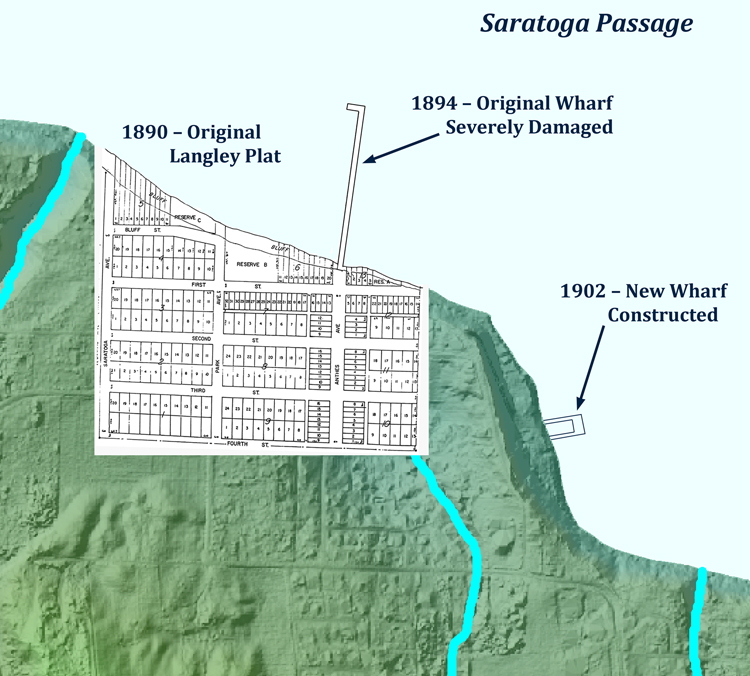
Original 1891 plat of Langley superimposed on a LIDAR image illustrating the locations of the original wharf and new wharf (Courtesy Robert Waterman).
The new wharf was U-shaped so a horse and wagon would not have to back up to turn around. Two warehouses, each with a smaller building at their end, and a privy were built at the end of the wharf. A flagpole, a water tank, and a small house completed the marina.
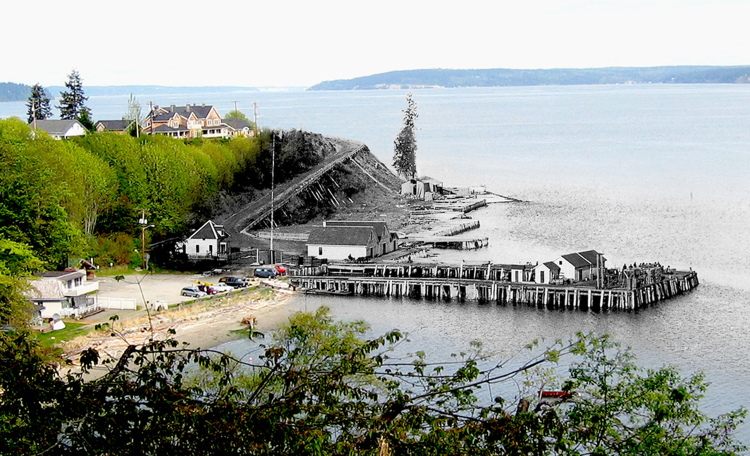 Composite of new wharf (1904) and town above (2016) (Courtesy Helene Ryan and Robert Waterman).
Composite of new wharf (1904) and town above (2016) (Courtesy Helene Ryan and Robert Waterman).
A breakwater of wooden pilings was constructed and riprap and dirt from the road scraped along the bluff were placed behind it to create land for several warehouses and a small shingle mill.
The new wharf was U-shaped so a horse and wagon would not have to back up to turn around. Two warehouses, each with a smaller building at their end, and a privy were built at the end of the wharf. A flag pole, a water tank, and a small house completed the marina.
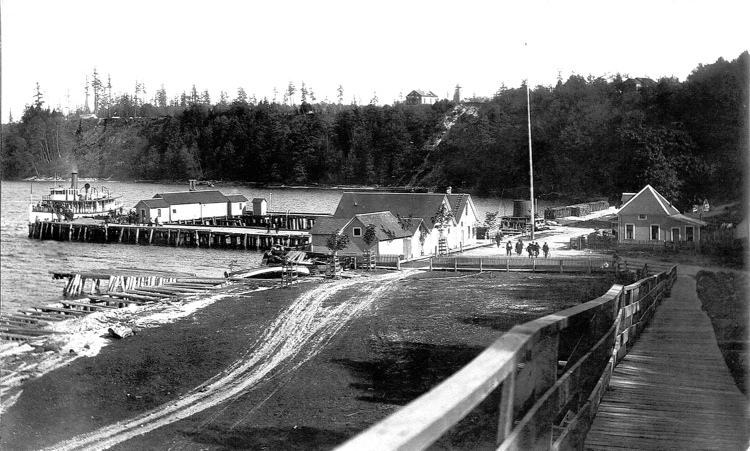
1911. Passengers from the steamship "Whidby" begin the long walk up into town (Courtesy Mary Solak).
A wooden plank sidewalk was added along "Anthes Road" (Wharf Street) for passengers arriving via mosquito fleet steamers.
Although the wharf was more protected from storms, its new location separated the activity associated with the marina from the developing town up on the bluff - a situation that continues to pose a problem for the city today.
1912 - 1920: Commercial and Community Center
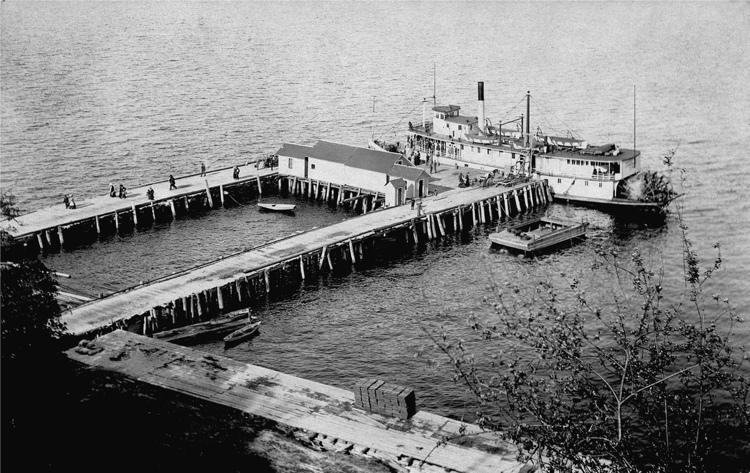
Circa 1910. Sternwheeler Fairhaven at the Langley wharf (Courtesy Anna Primavera).
Barges, like the one anchored off the side of the wharf in the photo above, were used to ship small branches and saplings to Seattle and Everett to be used as riprap as those cities enlarged their ports. This provided an important economic boost to the developing town.

1910. Loading brush at the Langley wharf (Courtesy Helen Hulbert).
1912 - 1920: Commercial and Community Center
Hans Peter Jensen bought the wharf in 1911 and began to make improvements. A canning company and adjacent creamery were built at the foot of the wharf. A new warehouse was constructed at the end of the wharf. Buildings at each end of the initial warehouses were moved to the foot of the north arm of the wharf and placed together to form a popular "watering hole" called the Sea Breeze Confectionary.
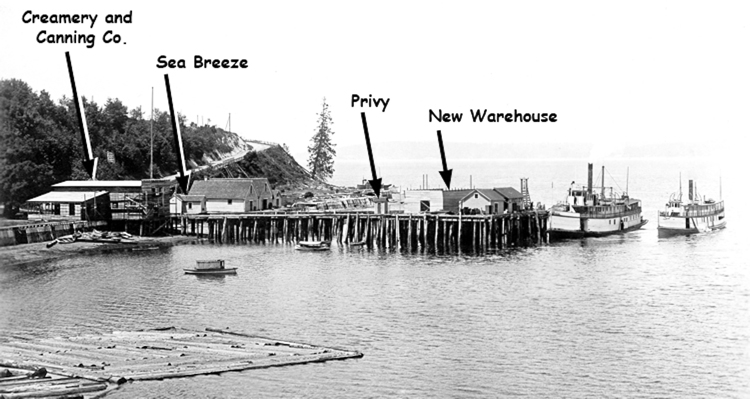
1912. Improvements underway (Courtesy William Hunziker).
By 1918, the wharf and marina had become a busy commercial and social center.
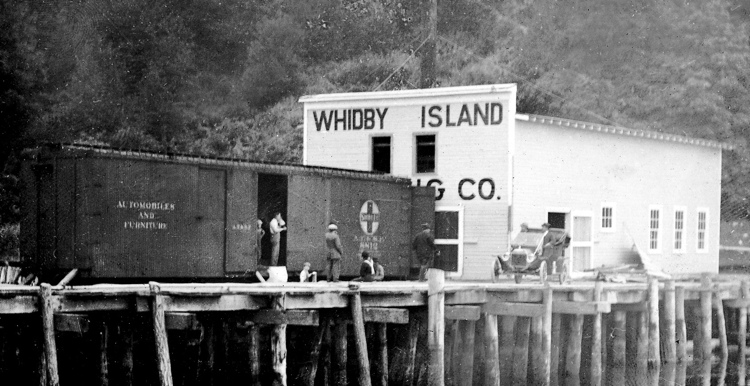
Circa 1915. Box car being loaded at the Whidby Island Canning Company (Courtesy South Whidbey Historical Society).
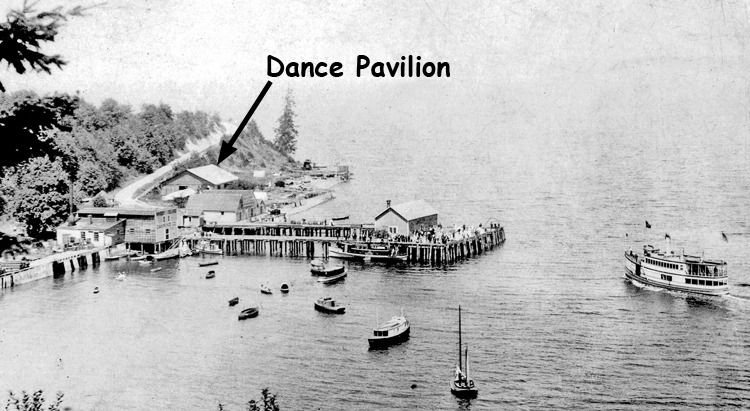
Circa 1918. Langley Wharf and Dance Pavilion (Courtesy Douglas McLeod).
A large dance pavilion was constructed in 1914. In addition to dances, the pavilion housed exhibits during the Island County Fair that was held at the marina from 1917 - 1920.
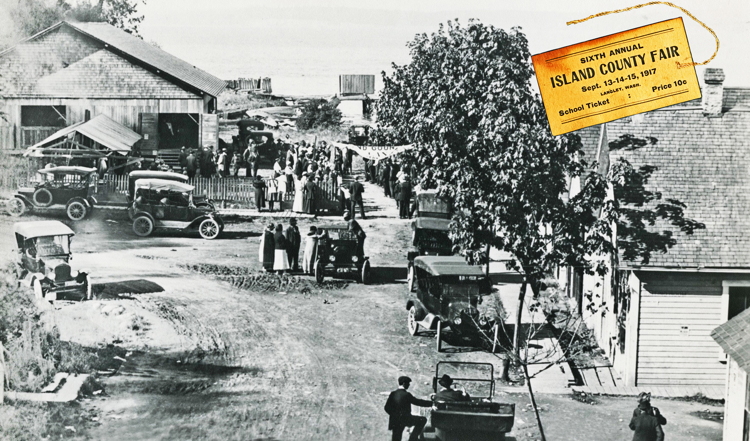
1917. Island County Fair (Dance Pavilion upper left) (Courtesy South Whidbey Historical Society).
The marina was also a popular site for swimming, fishing, and community picnics and clambakes.

Circa 1916. Clambake at the Marina (Courtesy Darrell Corbin),
1920 - 1930: Car Ferries and Standard Oil
The dance pavilion was torn down in 1920. The Standard Oil Company purchased the property and constructed several oil storage tanks and an office on the site.

Circa 1923. Car ferry "Whidby II" at the Langley Wharf (Courtesy Darell Corbin).
The first car ferry to the Island appeared in 1919. One of the ferries serving Langley beginning in 1923 was the "Whidby II".
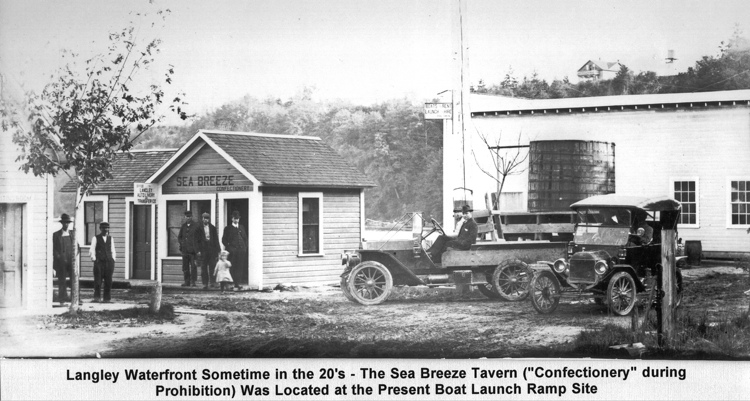
Circa 1923. Sea Breeze Confectionary and adjacent Cannery building (Courtesy Anna Primavera).
The Sea Breeze Confectionary also served as a waiting room for passengers. The Sea Breeze eventually moved into the vacated Cannery building.
After a protracted battle for routes between two ferry companies, the "Whidby II" made it's last trip to Langley in December 1929, and all car ferries subsequently went to Clinton.
The Great Depression
Faced with decreasing traffic to Langley, a group of Langley's citizens formed the Langley Dock Company, Inc. in 1926 with a goal of preserving economic activity at the Marina. They purchased the property along the waterfront and the Wharf in 1928.
In 1930, a berry packing plant replaced the original warehouses at the foot of the dock. Strawberries from all parts of the Island were packed in barrels and shipped to Everett and Seattle.
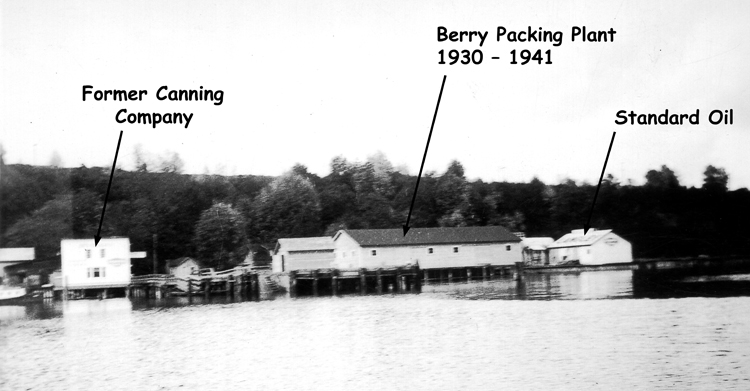
Circa 1935. Berry Packing Plant (Courtesy Joan Handy).
In 1936, the Dock Company divided the property into lots and platted the Sunrise Beach Addition to the Town. Members of the Dock Company each received one or more lots. Cottages and homes were built on lots north and south of the dock.
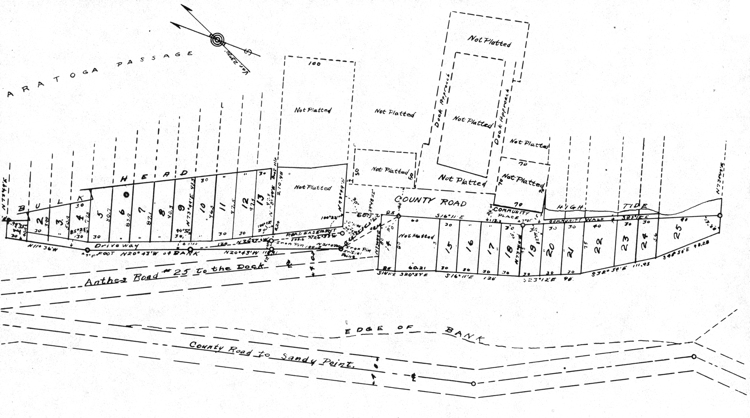
1936. Plat of Sunrise Beach Addition (Courtesy Langley City Hall).
The deteriorating wharf was rebuilt by the WPA in 1939.
The Dock Company sold the wharf and tidelands to the Town of Langley for $1.00 in 1939 and disbanded.
1940 - 1971: Fishing Resort
In 1941, Leone and Arvid Hansen purchased lots 10 and 11 and began construction of what became the Sunrise Beach Resort. They built seven small cottages and remodeled a larger Langley Boat Works building to create a popular fishing resort. Walter Kinney purchased the resort in 1945 and added three more cottages. in 1959, the Kinney's sold the resort to Hal and Flo Hahn who ran it until 1971.

1942. Sunrise Beach Resort cabins and Boat Works building (left) (Courtesy Flo Hahn).
Langley’s strawberry packing plant closed in 1941 and was replaced by a brush packing plant in 1943. Huckleberry, salal and sword ferns from the island were shipped to Everett and loaded onto box cars to be distributed to florists in the eastern United States.
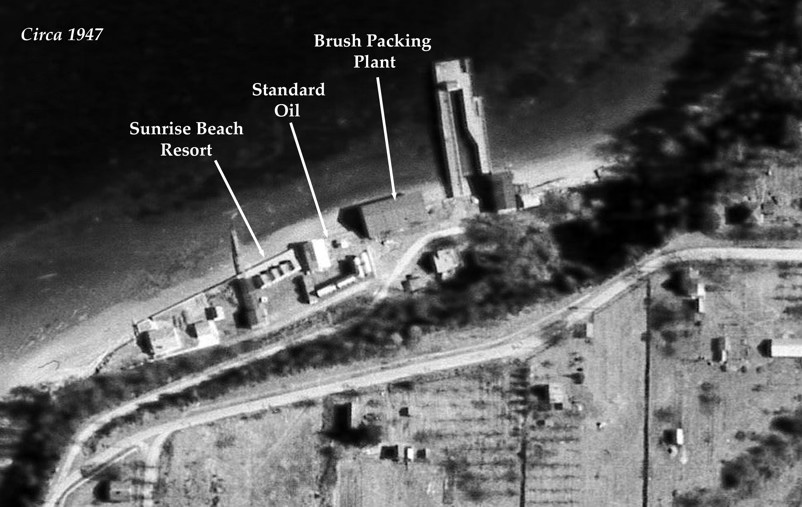
Circa 1947. Aerial view (Courtesy Island County).
1954 – 1964: Round–the–Island Boat Races
Round-the-Island motorboat races began in 1954 with boats leaving from Holmes Harbor. The starting point was moved to Langley in 1957. The "Around Whidbey Island Outboard Marathon Race" sponsored by the Langley merchants drew approximately 50 boats of several classes.
Fredrick and Carl Frei won the race in 1958 in two hours and fifty-five minutes.
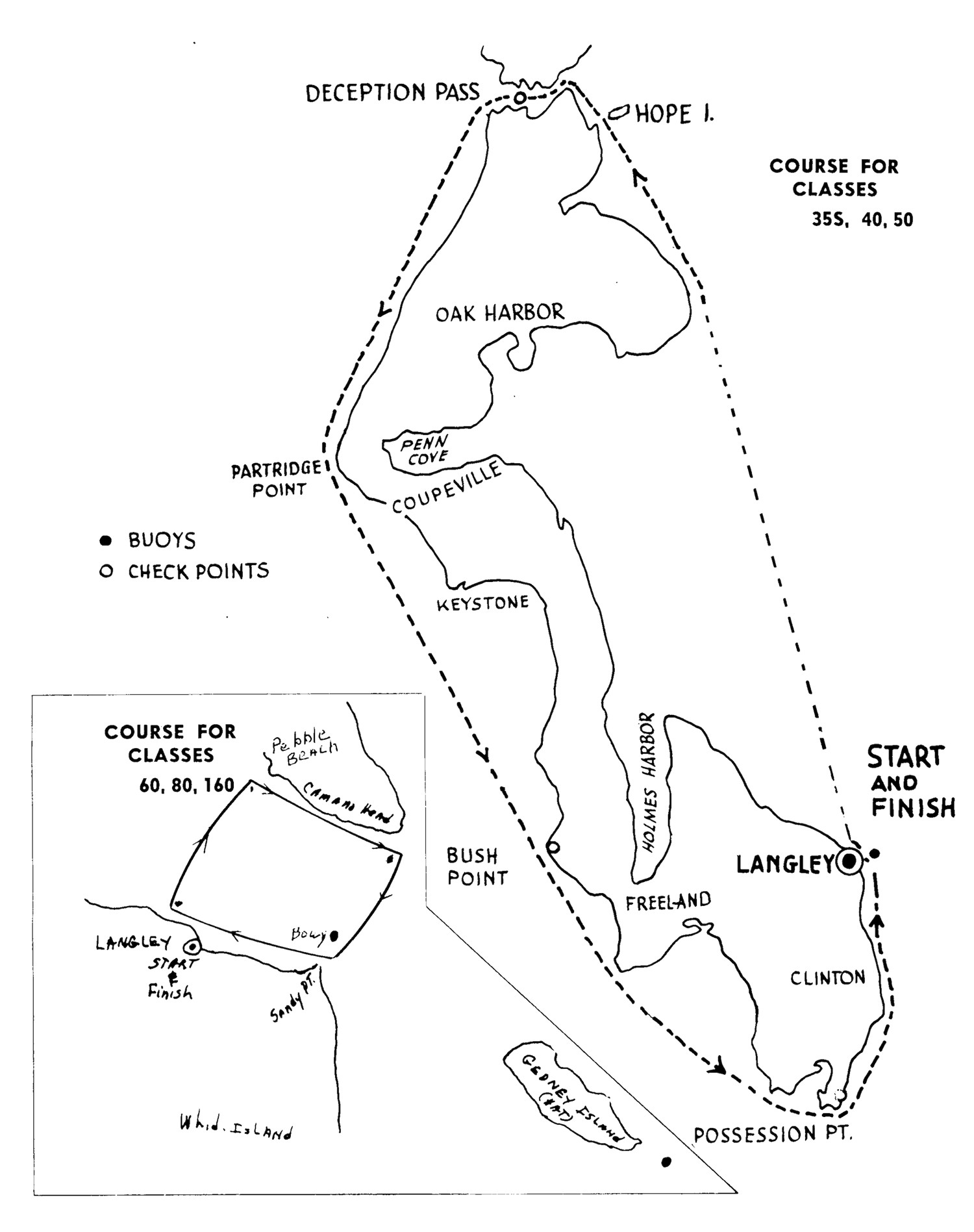
1961. Race map (Courtesy Robert Noble).
In 1961, two courses for different size boats were set out: one around the Island and a rectangular course in Saratoga Passage between Langley and Camano for boats making 10 laps.
Other events – Smorgasbord dinner, card party, bake sale, dance, pancake breakfast, bingo – preceded and followed race day at locations on the south end of the Island.
1959: Hein's Langley Marina
Bernard ("Barney") Hein and his wife Marjorie purchased the packing plant and remodeled it into the "Langley Marina" that opened in 1960. They added living quarters and built a dock.
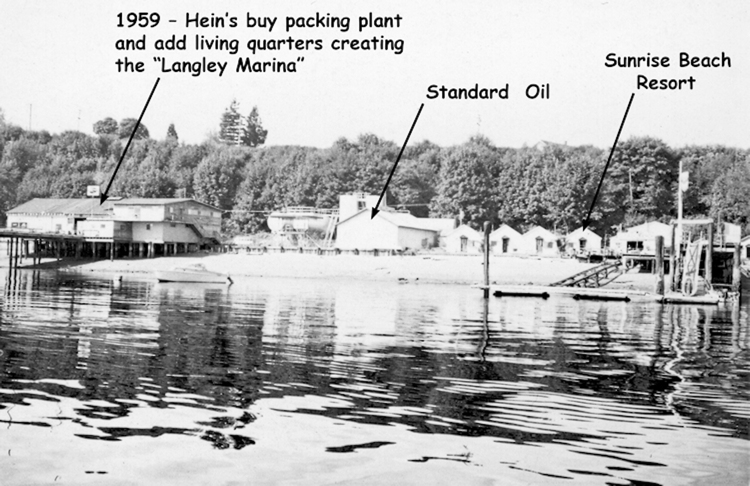
1960. Hein's Langley Marina and Sunrise Beach Resort (Courtesy Flo Hahn).
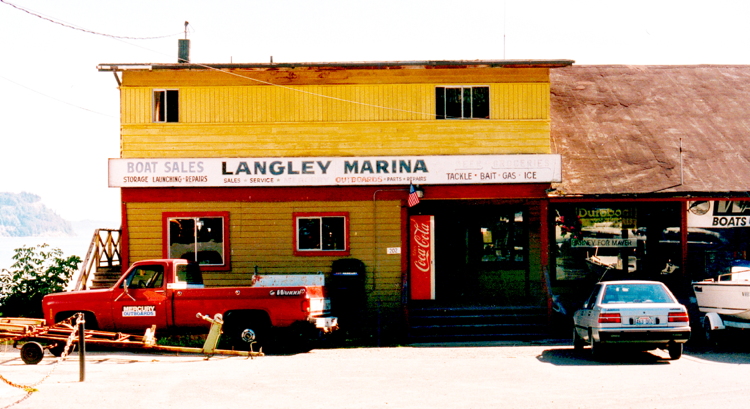
1995. Langley Marina (Courtesy John Adams).
Evolution of the Wharf
The South leg of the wharf was demolished in the 1950s, and two floats were anchored alongside in the summer months.
On August 29, 1961, voters on Whidbey Island approved the formation of the Langley Port District to develop an all-season boat marina in the town of Langley.
Beginning in 1965, the Port began preparations for a 6.8-acre marina and harbor facility at the site of the original pier at the foot of Anthes Avenue. This proved financially untenable, and the idea was scrapped.
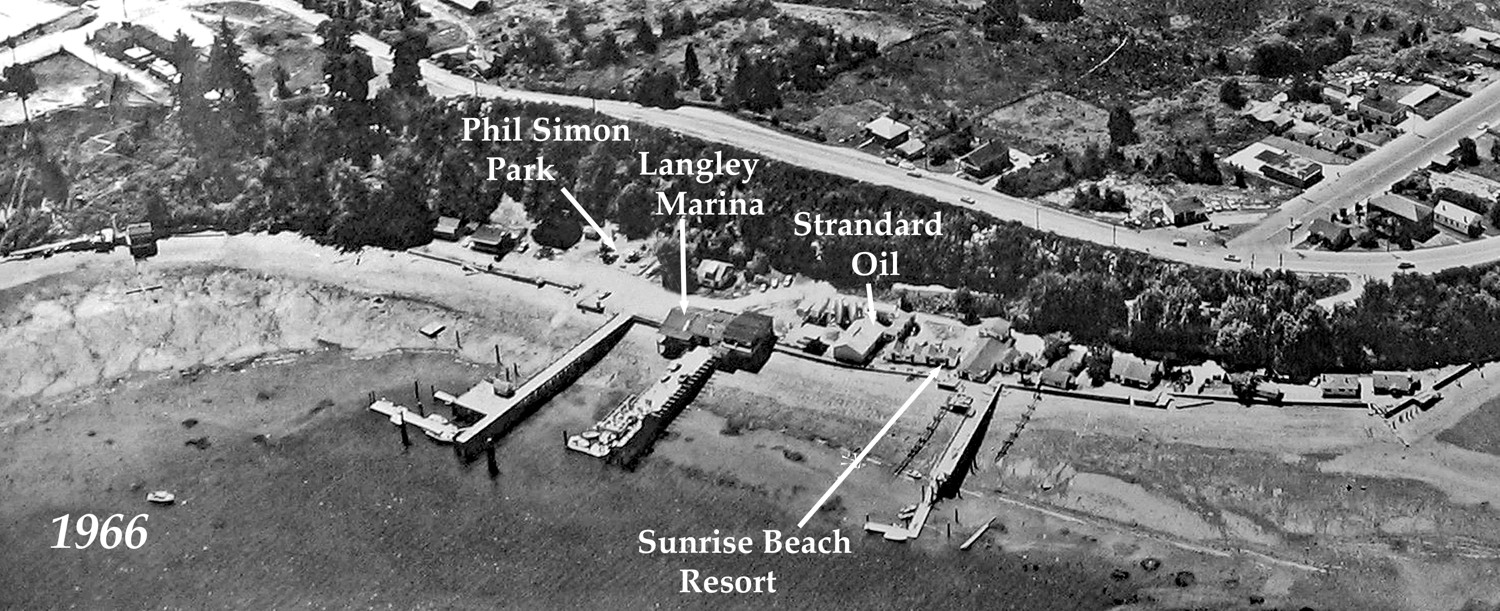
1966. Aerial view.
In November of 1979, the name of the district was officially changed to "The Port District of South Whidbey Island."
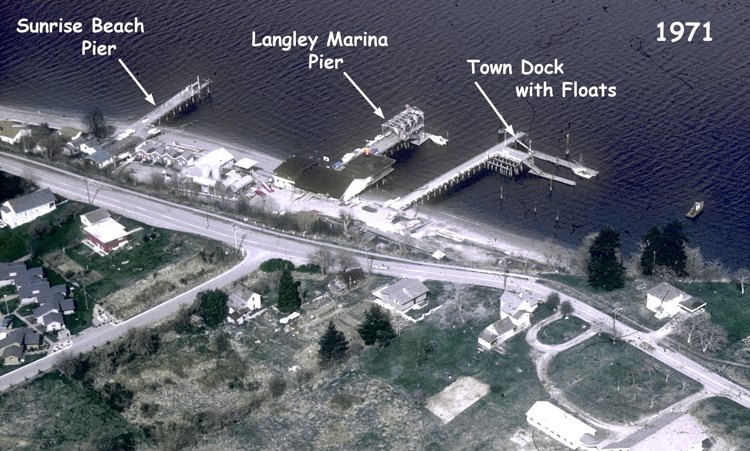
1971. Aerial view (Courtesy Ben Breedlove).
In 1976, the city closed the dock to the public due to deterioration. In November of 1979, the name of the district was officially changed to "The Port District of South Whidbey Island."
In 1979, the Port of South Whidbey joined with the City of Langley and the state's Interagency Committee for Outdoor Recreation to develop a transient-moorage marina to be called the Langley Boat Harbor.
The facility, which could accommodate approximately 40 small vessels, consisted of floating, concrete finger piers anchored to treated timber pilings, all protected by a floating tire breakwater.
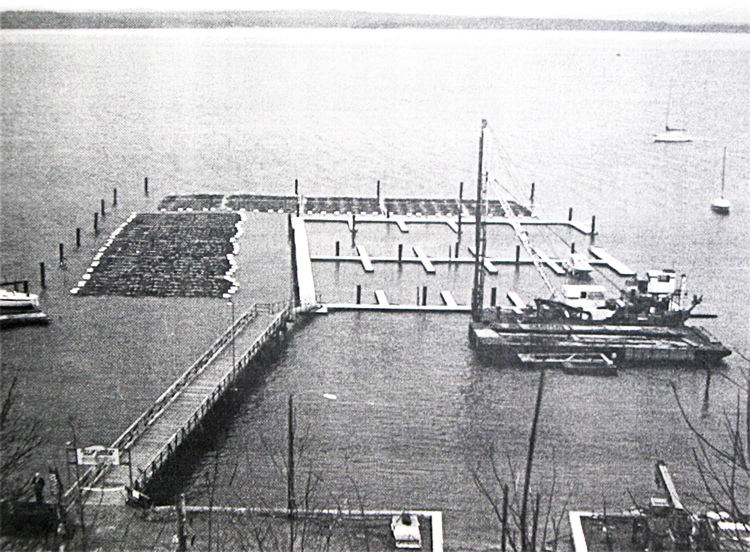
1979. New marina with floating tire breakwater (Courtesy Langley City Hall).
The tire breakwater sank in 1986, and the Port of South Whidbey contributed $30,000 toward replacing the breakwater and upgrading the facility. The work was completed in 1986.
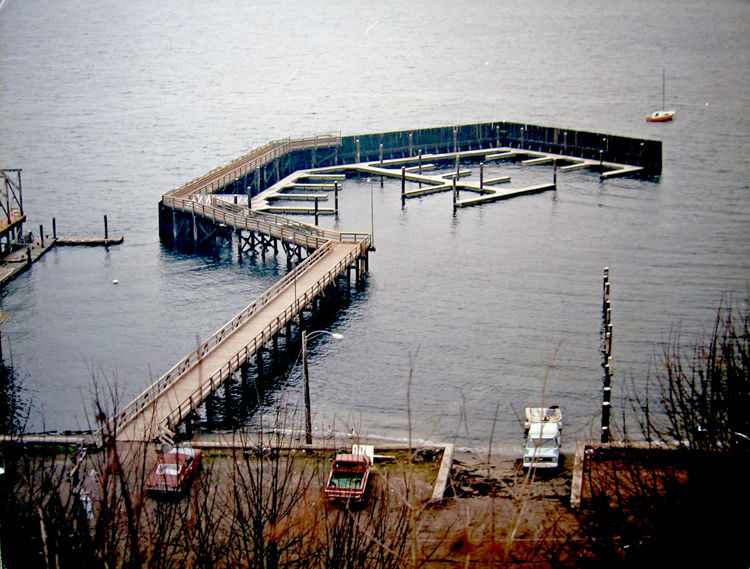
1986. The new wharf (Courtesy Langley City Hall).
Nichols Brothers Boat Builders of Freeland, Washington, purchased the Sunrise Beach Resort property in 1979 for outfitting and repair work. The old Langley Boat Works building was preserved, but the cottages were removed, and the resort pier was replaced by a new dock.
The Standard Oil tanks were removed and replaced by a ten-unit Boatyard Inn constructed by Paul Schell and his partners in 1995.
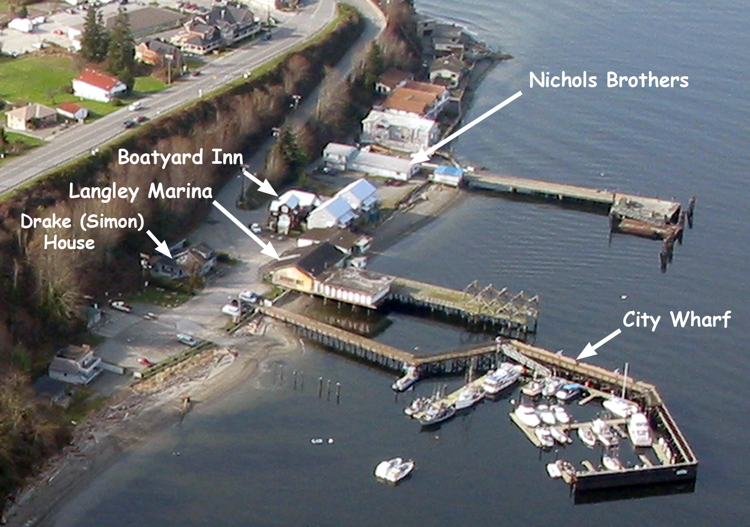
2004. Langley harbor (Courtesy John Scurlock).
The deteriorated Langley Marina building was demolished in 2005 and replaced by a new Boatyard Inn unit in 2010. Only the pilings of the Marina dock were left in place.
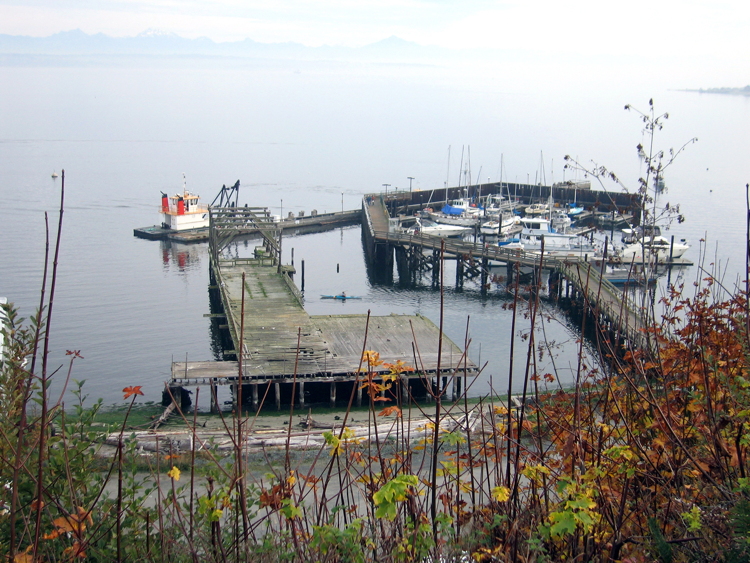
2007. A concrete breakwater being towed into place. (Courtesy Robert Waterman).
A concrete breakwater was towed to Langley and eventually attached to the wharf to provide moorage for larger boats.

2018. Breakwater anchored to provide additional moorage (Courtesy Robert Waterman).
The City transferred the marina to the Port March 2, 2009, and the name of the marina was changed to the "South Whidbey Harbor at Langley."
Phil Simon Park
George Phillip ("Phil") Simon came to Langley from Mukilteo in 1910 and occupied the little house at the foot of the wharf with his wife and children until his death in 1959.
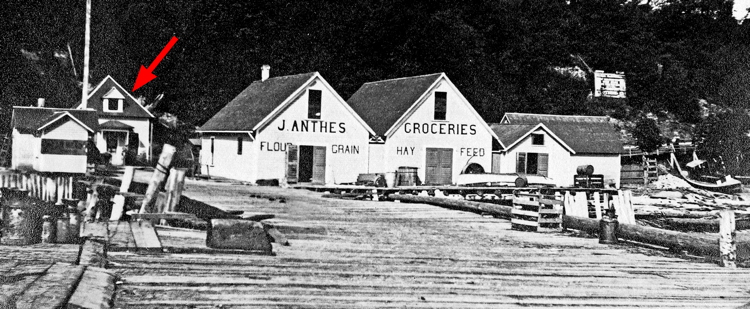
Circa 1918. Phil Simon house (arrow) (Courtesy South Whidbey Historical Society).
The house was enlarged as his family grew.
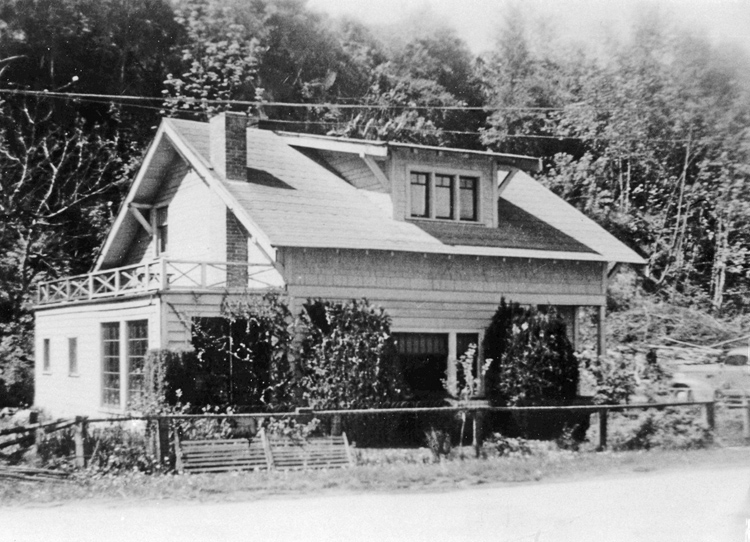
Circa 1940. Phil Simon House (Courtesy South Whidbey Historical Society).
The house fell into disrepair after Phil's death. Robert Drake purchased the house in 1983 and renovated it into a B&B called Drake's Landing that opened in 1985.
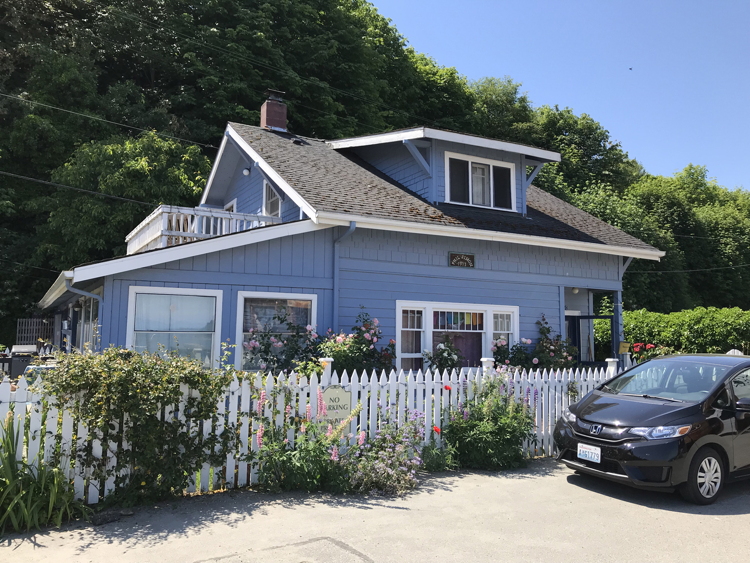
2018. Drake's Landing (Courtesy Robert Waterman).
PhilSimon made many contributions to Langley. He ran the Sea Breeze Confectionary, made and sold ice cream, installed the Town's water system, served as Langley's first fire marshal, rented boats, ran a jitney service, and ran Langley's electrical plant from 1916 to 1930.
In 1967, the City established a small park honoring Phil Simon at the base of the bluff adjacent to the former Phil Simon house. The Port of South Whidbey constructed an enlarged Phil Simon Park at the water's edge in 2009.
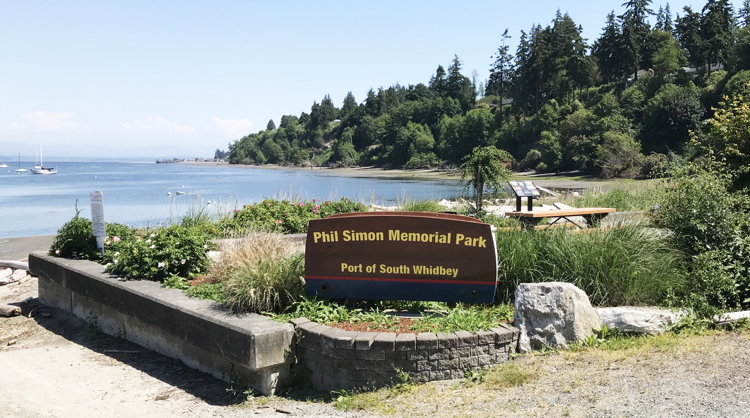
2018. Phil Simon Park (Courtesy Robert Waterman).

2024. Boatyard Inn unit (Courtesy Robert Waterman).